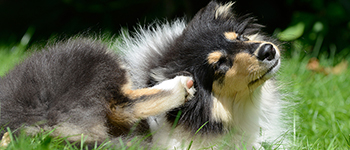Blog
How To Control Fleas on your Pets
22/05/2019
Fleas are parasites of the insect family and are known for their ability to jump, thanks to their strong back legs. They are easy to recognise, as they have a flat body, three pairs of legs and a mouth specially designed to suck blood. However they can be difficult to spot, due to their tiny size (fleas are only around 2-3 mm in length), especially if pets with a dark, long or thick coat. This means you might not be aware of them until you find a fleabite on your pet or you.

They like to get around and can hitch a lift on all sorts of animals; such as chickens, pigeons, foxes and hedgehogs, as well as cats, dogs and humans. Aside from causing itchy bites and sometimes anaemia in younger animals, these parasites can carry nasty infections (e.g. bacteria, worms), which they can pass on to their host as they feed.
These creepy critters are the athletes of the insect world and can move at an impressive pace, quickly hopping out of trouble (or the flea comb) at lightning speed.
The flea lifecycle and your pet
Fleas spend their whole life (on average 1-3 weeks) on the same host, until they are groomed out. Their lifecycle begins when a flea hops onto your unsuspecting pet as they are wandering around the garden, frolicking in the park or snoozing on their favourite rug.
Once on board, they will search for a fellow flea mate before the female flea starts laying eggs within just 48 hours of hopping onto your pet if both male and female fleas are present. However, flea eggs are not sticky so they will easily roll off your pet’s coat and into the environment, which could be your home or outdoors.
After around 2-5 days, these pearly white eggs will hatch out and maggot-like larvae will emerge. Because flea larvae hate the light they quickly scurry off to the darkest nooks and crannies they can find; under furniture, along skirting boards, between floorboards and deep into carpets and rugs.
Here they will start to spin a silk-like protective cocoon around themselves and become a pupa. Between 14 days to several months later (depending on the environmental conditions), a fully developed flea will then hatch out. They then head upwards to the surface of the carpet or wherever they have been hiding, and eagerly start searching for a host for their first blood-meal, and the cycle begins once more.
Where do fleas come from?
These pesky critters can be found just about everywhere, including your favourite walk, local park and even in your own home and garden. But how did they get there in the first place?
-
Wildlife & stray cats
Your pet isn’t the only place fleas like to hang out, as they can also infect wildlife like foxes and hedgehogs, as well as stray cats. It’s not uncommon for urban wildlife (or stray cats) to wander into your garden under the safety of night.
Unfortunately, if they have a flea infestation, they may also leave behind a trail of flea eggs. These eggs will then develop and fleas hatch out in the safety of your garden. These newly-hatched fleas will be eager for their first meal and your cat or dog could end up with some unwanted friends on board.
-
Other pets
Although the chances of a flea hopping onto your pet from another pet are relatively slim, untreated pets can still pollute your pet’s favourite haunts (e.g. park, woods) with flea eggs.
-
Your home
Nowhere is safe from fleas. These parasites really do get everywhere and some may even be lurking in your home. In fact, 95% of a flea problem can be found in the home, hidden in carpets and soft furnishings in the form of eggs, larvae and pupae (cocoons).
Also, under optimal conditions, female fleas can lay as many as 50 eggs per day, which can develop into fleas in as little as 14 days. So, your home could be an hive of activity in no time, with 50 eggs becoming 1000 eggs in just three weeks during warmer months.
Flea hot-spots can quickly develop in the places that your pet likes to spend most of their time. For example, this could be their bed, on the sofa, by the radiator or even on your bed if this is where they go for their cat-nap.
How to control fleas
Prevention is easier than cure, so, the good news is that there are a few simple steps that you can take to achieve this:
- Vacuum regularly
Stay on top of your housework, this will help to get rid of any immature fleas that may have made it into your home and be hiding in your carpets and soft furnishings.
- Treat your pets from fleas
Using a flea treatment on your pet regularly and throughout the year will get rid of any hitchhiker fleas before than can even say “dinner”. Remember, because we now have milder winters, and thanks to central heating, fleas can now survive and thrive all year round so your protection programme should mirror this. Remember, even those pets that don’t leave the safety of their home or garden are still at risk of fleas.
- Check them regularly
Don’t forget to give your furry friend a regular comb to check for fleas and flea poo. It won’t take long and could help you to get rid of any fleas before they have a chance to start their flea family
How Can I Get Further Information?
This information is brought to you for advice, but is not meant to replace the need for you to ensure that you consult with a vet or trained staff in your local store for health advice for your pets. Always seek specialist advice when selecting animal medicines.